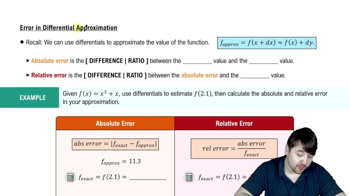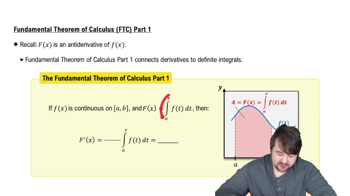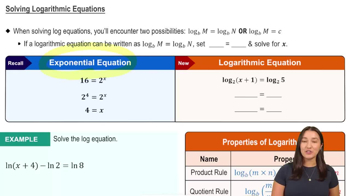The range R of a projectile fired from the origin over horizontal ground is the distance from the origin to the point of impact. If the projectile is fired with an initial velocity at an angle with the horizontal, then in Chapter 13 we find that R-v_0^2/g(sin 2α) where g is the downward acceleration due to gravity. Find the angle α for which the range R is the largest possible.
Table of contents
- 0. Functions7h 54m
- Introduction to Functions16m
- Piecewise Functions10m
- Properties of Functions9m
- Common Functions1h 8m
- Transformations5m
- Combining Functions27m
- Exponent rules32m
- Exponential Functions28m
- Logarithmic Functions24m
- Properties of Logarithms36m
- Exponential & Logarithmic Equations35m
- Introduction to Trigonometric Functions38m
- Graphs of Trigonometric Functions44m
- Trigonometric Identities47m
- Inverse Trigonometric Functions48m
- 1. Limits and Continuity2h 2m
- 2. Intro to Derivatives1h 33m
- 3. Techniques of Differentiation3h 18m
- 4. Applications of Derivatives2h 38m
- 5. Graphical Applications of Derivatives6h 2m
- 6. Derivatives of Inverse, Exponential, & Logarithmic Functions2h 37m
- 7. Antiderivatives & Indefinite Integrals1h 26m
- 8. Definite Integrals4h 44m
- 9. Graphical Applications of Integrals2h 27m
- 10. Physics Applications of Integrals 3h 16m
- 11. Integrals of Inverse, Exponential, & Logarithmic Functions2h 31m
- 12. Techniques of Integration7h 41m
- 13. Intro to Differential Equations2h 55m
- 14. Sequences & Series5h 36m
- 15. Power Series2h 19m
- 16. Parametric Equations & Polar Coordinates7h 58m
5. Graphical Applications of Derivatives
Applied Optimization
Problem 4.5.53a
Textbook Question
53. Distance between two ships At noon, ship A was 12 nautical miles due north of ship B. Ship A was sailing south at 12 knots (nautical miles per hour; a nautical mile is 2000 yd) and continued to do so all day. Ship B was sailing east at 8 knots and continued to do so all day.
a. Start counting time with t=0 at noon and express the distance s between the ships as a function of t.
 Verified step by step guidance
Verified step by step guidance1
Start by identifying the positions of the ships at noon. Ship A is 12 nautical miles north of Ship B, so the initial position of Ship A relative to Ship B is (0, 12) in a coordinate system where north is positive y and east is positive x.
Determine the position of Ship A as a function of time t. Since Ship A is moving south at 12 knots, its position at time t is given by (0, 12 - 12t).
Determine the position of Ship B as a function of time t. Since Ship B is moving east at 8 knots, its position at time t is given by (8t, 0).
Calculate the distance s between the two ships using the distance formula. The distance s is given by the formula:
Simplify the expression for s to express the distance between the ships as a function of time t. This involves expanding the squares and combining like terms.
 Verified video answer for a similar problem:
Verified video answer for a similar problem:This video solution was recommended by our tutors as helpful for the problem above
Video duration:
4mPlay a video:
Was this helpful?
Key Concepts
Here are the essential concepts you must grasp in order to answer the question correctly.
Relative Motion
Relative motion involves understanding how the position of one object changes with respect to another. In this problem, ship A moves south while ship B moves east, creating a right triangle where the legs are the distances each ship travels over time. Calculating the distance between the ships requires understanding how these movements relate to each other over time.
Recommended video:

Determining Error and Relative Error
Pythagorean Theorem
The Pythagorean Theorem is essential for finding the distance between two points in a plane, especially when they form a right triangle. Here, the theorem helps calculate the hypotenuse, which represents the distance between the ships, using the formula s = √(x² + y²), where x and y are the distances traveled by ships B and A, respectively.
Recommended video:

Fundamental Theorem of Calculus Part 1
Parametric Equations
Parametric equations express the coordinates of points as functions of a parameter, often time. In this scenario, the positions of ships A and B are functions of time t, with ship A's position given by (0, 12 - 12t) and ship B's by (8t, 0). These equations allow us to express the distance between the ships as a function of time, crucial for solving the problem.
Recommended video:

Solving Logarithmic Equations

 1:13m
1:13mWatch next
Master Intro to Applied Optimization: Maximizing Area with a bite sized video explanation from Patrick
Start learningRelated Videos
Related Practice
Textbook Question
